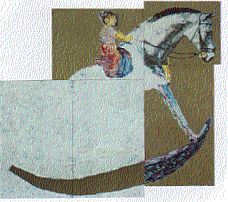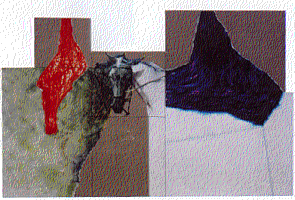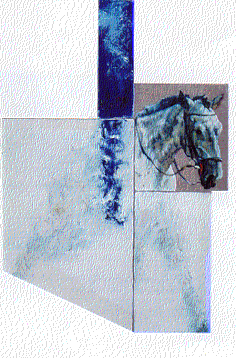
He gave collective titles to each of his exhibitions: Barbarian Geometry, Bodimage, Pending Pictures, Chimera, Daedalus—Icarus, and now Chimera again. (I do not include the respective dates of these exhibitions here, they can be looked up in this catalogue.)
For Helényi, the titles of pictures and exhibitions are almost of equal importance to the composition and the act of painting itself. All of his paintings are figurative, he only paints men and horses, or groups of these. His basic characteristic is a masterly ability of drawing, the strictness of composition, and a superior knowledge of various materials. His trade mark is the technique of omission. In his view, the raw canvas, so close to the organic world, is something for display, rather than to be covered up.
As the creator of applied art, he has designed an unusually hard and not very prolific method for designing his posters, magazine and book covers. He starts out with painting the picture with the traditional methods, using canvas, oil, and the tip of the brush, and then he makes a colour transparency reproduction of the finished image. This transparency is used in print for poster production. In this genre, his poster for the Paul Klee exhibition in Budapest is a significant achievement in art history.

As stated above, the most important features of this artist are the amazing drawing skills and the jugglery of perspective. His lines and tones are reminiscent of renaissance art, and the art of mannerism, flourishing between the age of renaissance and baroque. Very probably, since Bertalan Székely in the late 19th century, no one has been exploring the anatomy and choreography of the horse as thoroughly as Helényi does. The catalogue of his exhibition Barbarian Geometry is a mock-comic book comprising scenes of warriors and horses, complete with calligraphic writing which only imitates writing, no one can read it. Helényi is not only the master of neo-mannerism, and post-pop-art, but also the master of neo-dadaism. His attitude can be called the creation of a private mythology; although, to the best of my knowledge, he has never fought on horseback, nor with a lance to date.
His Bodimage pictures represent a kind of human geometry, the name is coined up from the words „body” and „image”. He may have turned towards the archaic because these paintings — lovingly and hatingly — conjure up the spirit of the 19th century Munich Academy of Art. This collection has a consistent iconography: it all about the human body, more specifically, the male nude. Each of the pictures has a static character, the individual figures all adopt a frontal posture, with the exception of those who turn their backs to the viewer. Bodimage is of a dualistic character: these paintings represent the surface, the outward appearance of the human body, and at the same time, using I and X shaped auxiliary lines, they display the structural canon, the geometric regularity of the human figure.

Next, the artist has consciously waived the organised nature of the Bodimage paintings, and created his next, possibly greatest exhibition, Pending Pictures. The subject matter of these suspended paintings has not changed, it is all about living creatures: men and horses, or the two together. The static period has come to an end. Helényi’s art has always been rich in colour, but these paintings display colours in their purity, unmixed. The warm and cold hues are displayed clashing in a battle of brush strokes. This period can be characterised as intense, loud, dynamic, or even rustic. Precision of structure is there, but it is hidden beneath the surface — as the artist’s latest trick.
The basic principle of Chimera is compilation. Helényi now represents eclecticism within every single picture, and as a denomination, he borrowed the term, the name of a monster with a lion’s head, a goat’s body and a serpent’s tail, from ancient Greek mythology. The smoothness of painting, reminiscent of 19th century „Biedermeier” art, mingles with rustic and rough expressionism, and the third main element is the raw surface of the canvas.
Seeing the title of the next exhibition, Daedalus—Icarus, one might assume that the subject matter is universal mythology again. The only painting displayed on this exhibition was fastened to the ceiling, above the barren walls. The composition represented the two characters, Daedalus and Icarus, father and son, as one single figure. The artist has used a technique of extremely thick underpainting with plastic materials, to achieve an almost 3-dimensional effect. The viewer, when entering the hall, first interpreted the painting as the image of the soaring father, Daedalus. While leaving the hall, the same painting represented the tragic fall of his son Icarus.
The exhibition at Kiscelli Museum in the year 2000 has the title Chimera again, because the artist regards this as a direct sequel to his 1992 collection of the same name. The subject matter is, as it has been for a long time, the horse and its rider. When asked why he is preoccupied with horses, his reply was characteristically structural: the human figure is but a vertical line, while the horseman represents a rectangle.
For these pictures, he used his traditional working method, by painting a small scale model — not just a sketch — of the picture, and then paints it again in the accurate dimensions. In this case, some of his paintings are enlarged to 9 square meters, maybe because he wanted them to look more impressive in the chiaroscuro church vault environment of the Kiscelli Museum.
As a matter of fact, paraphrasing the title of Barbarian Geometry, I would call this collection „bucolic geometry”, even though no lambs or shepherds are shown to give an Arcadian impression. Geometry is not the main line of Helényi, he is far from being a constructivist, but his excellence of composition derives from his affinity to geometric shapes.
His large paintings are divided into smaller segments (for practical, transportation reasons to start with), and he reassembles them with barely perceptible, almost non-existent gaps.
Twenty years ago, a divided picture of the Bodimage collection represented a male nude with a wide hiatus, the bare wall at the waist. As it happened, I sent this painting „painting in two parts” to the Biennale of Belgrade. I was delayed by bureaucracy, so I arrived a little too late, just to realise that the two paintings were hung like two black or two white squares on a chess board, with their corners touching. The director of the Museum of Modern Arts in Belgrade had performed a trick different from Helényi’s intention: the technique of omission now involved omission of the artist himself... Needless to say, I had the two pictures rearranged as they were meant to be hung, one above the other. This story shows that the artist had already started to paint „one” picture on two pieces of canvas.
Later, evolving from his hyper-realistic, expressionistic horses-and-horsemen compositions, he created his own characteristic „Helényi’s analytic cubism” which has — luckily — nothing to do with textbook cubism.
„Bigwhite” represents a rocking horse, but the horse’s head and neck, and the harness gear are the exact portrayal of a real, living horse; the rest of the image is expressive, complete with lively planes in the background. A disproportionally small girl is riding on the back of the horse, with a happy expression on her face. The horse is shown in an enormous size, as in a child’s imagination.
„A white cross within a blue wedge” is a diagonally oriented, split composition. It is an extremely foreshortened depiction of a horseman, made up of passionate and expressive patches, with a slanted cross on the horse’s head, against the background of a blue triangle, reminiscent of a rock.
„Lack of the Great Warrior” is also made up of several segments. The horse’s head is the only detail which can be logically explained, the rest is but turbulent planar painting over several stretches of canvas, arranged in displacement, so that the gaps between the individual pieces represent the inverted figure of the horseman.
Helényi’s rightful and captivating heritage is portrayed in the picture called „The ‘Der Blaue Reiter’”. The name comes from a group of artists of many nationalities and various styles, but all living in Germany before World War I. Franz Marc, one of the founders phrased their objective: „creating a tradition is braver than exploiting it”. Well, here we are — Tibor Helényi has revived this tradition on this picture, in the year 2000. The head and neck of the horse is seen from semi-profile, combined with vibrantly painted blue squares. After the blue horse, a brown one comes next, „Hiding Horseman”. The horseman is unseen, and the body and legs of the animal are also missing from this triangular portrait of a horse.
„Sunshine, moon shadow” looks like an open book or like the inner pages of an open invitation card, with a bright and a dark page. In the middle, like on the back of a book, a narrow rectangle is seen at top, with an en face portrait of a horse.
These eleven pictures of this church vault exhibition (with paintings of such large dimensions, eleven pieces are ample) are unyieldingly about one and the same subject: the horse and the horseman. And yet, each of them are different from all the others, each disproving and contradicting the next. The collection presents eleven surprising solutions to one single theorem.